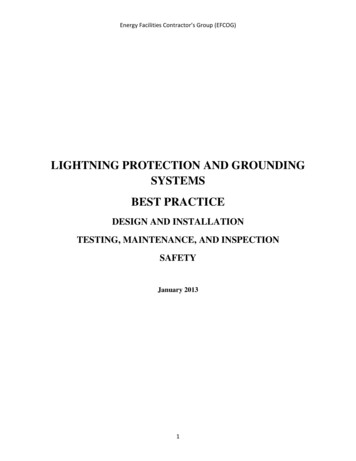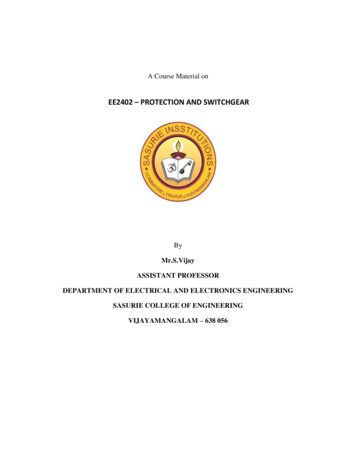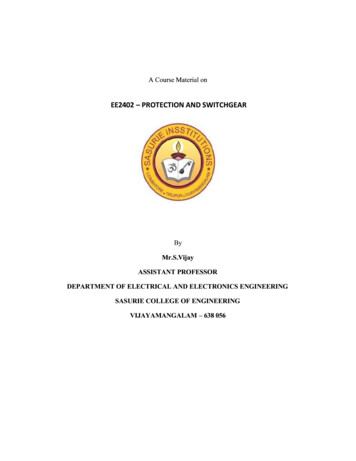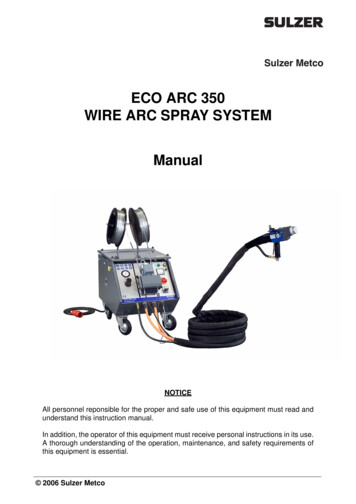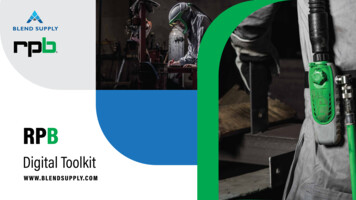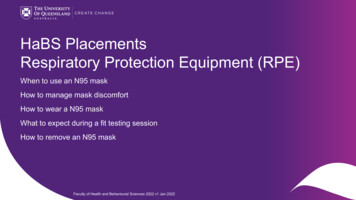
Transcription
HaBS PlacementsRespiratory Protection Equipment (RPE)When to use an N95 maskHow to manage mask discomfortHow to wear a N95 maskWhat to expect during a fit testing sessionHow to remove an N95 maskFaculty of Health and Behavioural Sciences 2022 v1 Jan 2022
Learning OverviewThe purpose of the following slides is to; Understand respiratory hazards in clinical settings become familiar with wearing and removing an N95 mask manage mask discomfort; and, to understand the N95 “Fit Testing” processFaculty of Health and Behavioural Sciences 20222
Respiratory hazards in clinical settingsThe most common respiratory hazards in a clinical setting are airborne contaminants oraerosols such as biological contaminants, dusts, mists and fumesMore than one respiratory hazard can be present at the same timeWork activities can result in airborne contamination in the form of Particulates - e.g., biologicalcontaminants, dusts, mists, fumes, smokes, fibers.These tiny particles float in the air but are often not detectable by sight or smell. When inhaled,they can become trapped in your respiratory system and cause irritation or health problemsFaculty of Health and Behavioural Sciences 20223
Respiratory Protective Equipment (RPE)Respiratory Protective Equipment (RPE) is used when other controls are either not possible or notsufficient on their ownCorrectly wearing RPE can stop you from developing the symptoms of respiratory illness caused byinhalation of hazardous substances at workThe two main types of RPE are:- FILTERING RESPIRATORS (or air purifying respirators), which filter the air to remove harmfulsubstances to purify the air the worker breathes- SUPPLIED-AIR RESPIRATORS (or Breathing Apparatus (BA)), which provide a supply of clean air forthe worker to breathe from a compressed air tank or an air line. The air supply is separate from that ofthe work environmentFor the purpose of this training, only filtering respirators(N95) will be covered.Faculty of Health and Behavioural Sciences 20224
Respirator protection spectrumFiltering respirators(Air purifying)Surgeon’s maskProvide a barrier todroplets or splashes, butnot smaller airbornecontaminantsP2 disposable orhalf facerespiratorFull Breathing apparatus(Supplied ING RESPIRATORY PROTECTIONFaculty of Health and Behavioural Sciences 20225
How do particulate air purifying masks work?A particulate filter is NOT a screen or sieve, and particles are not collected by layering on ‘top’ of a filter;instead, they are captured as they pass through the filtering materialFilters are made of many layers of randomly oriented fibers - the more fibers and the thicker the filter themore efficient the filter at capturing particlesClean filterFaculty of Health and Behavioural Sciences 2022Used filter6
Queensland Health requirements for placement studentsCOVID is now widespread in our community, inresponse Queensland Health has escalated therisk level to High.This means that anyone working in a hospital orhealth service requires additional personalprotective equipment, that includes wearing anN95 mask.Before an N95 mask can be worn in aQueensland Health facility, fit testing must beperformed in accordance with the relevantAustralian Standard. AS/NZ 1715 – Respiratory protectiveequipment.Faculty of Health and Behavioural Sciences 20227
Mask or skin discomfortYou may experience some mask discomfort and experience some skin irritation when wearing thesemasks for a prolonged period of time. These can be managed by1. Take time to fit your mask before starting a clinical consultation. Ensure all folds in your mask havebeen used to optimise the correct fit for you and do not over-tighten following fit check procedures.2. Increase the frequency of application of moisturisers and emollients and consider using a richer andthicker type to protect dry skin. Apply before going to bed.3. Hydrate. Make sure you are drinking plenty of water as this can easily be forgotten.4. Sleep. Getting plenty of sleep and a skin-friendly diet with plenty of omega-3 and omega-6 fatty acidsall support a healthy skin barrier.5. Take regular breaks - ideally hourly - from wearing the masks to relieve pressure, reduce moisturebuild up and allow the skin time to recover.6. Seek advice. If you experience severe skin problems, please seek medical advice from your GP.Faculty of Health and Behavioural Sciences 20228
Medical AssessmentsPhysiological and psychological considerationsPhysiological considerationsRegular wearing of P2/N95 masks imposes and extra burden on cardiac and respiratory systems. Thus, aperson with a history of disorders in these areas should be medically assessed by a medical practitioner oran occupational health physician, especially where heavy work or prolonged wearing of RPE is anticipated.Psychological considerationsHelmet, hood and full facepiece RPE, especially when combined with full body protection, may give rise tofeelings of claustrophobia, isolation and anxiety in some people. Such people will find it difficult to performtheir work satisfactorily under these conditions. Training programs are available to assist users inovercoming such feelings of anxiety.Faculty of Health and Behavioural Sciences 20229
Respirator fit testingPreparing for your fit testing sessionBefore attending a fit testing session, please ensure you familiarize yourself with the following points toachieve a quality fit, failure to do so may prevent your mask sealing properly:1. Clean shaven face - No beards or any stubble length2. Long hair tied back3. No heavy foundations/makeupFaculty of Health and Behavioural Sciences 202210
How to wear a respirator / N95 mask – Halyard (Duckbill)1Separate mask edges (put a small bendin nose wire if needed)Ensure nose piece is at the top and2 bottomis completely unfoldedCup the mask under your chin and pullthe head bands up and over your head.3 Pull the top strap over your head.Position it high on the back of yourhead, above your earsHolding the respirator, pull the bottomstrap over your head and positionaround your neck and below your earsReference: Donning & Fit Checking of Respirator in NSW Healthcare Settings: Duckbill style P2 or N95 Respirator https://www.youtube.com/watch?v OloUcaHPKSQFaculty of Health and Behavioural Sciences 202211
How to wear a respirator / N95 maskthat the mask is not folded as4 Checkthat will prevent you from achieving aseal5 Starting at the bridge of your nose and 6 Continue to adjust the respirator andusing fingertips on either side of yournose, firmly conform the nose piece toyour nose and across cheek bones(pushing inward) - Do not pinch thenose piece with one hand as this maycreate a gap!secure the edges until you feel youhave achieved a good facial fit.Proceed to fit checking.Fit checking must be performed everytime you put on a new N95/P2 mask.CAUTIONAn incorrectly fitted mask willnot provide you with theintended level of protectionfrom airborne infectiousdiseases!Faculty of Health and Behavioural Sciences 202212
Fit checkingPOSITIVE seal fit checkNEGATIVE seal fit check Exhale sharply. While doingso, feel for air seeping throughthe mask.Disposable masks An unsatisfactory seal isindicated by the feel of anairstream channelling througha leak An unsatisfactory seal isindicated by the feel of anairstream channelling througha leak Inhale sharply (face-piecemay collapse onto face)If you find a leak, adjust the mask andrepeat until you get a good fit!Faculty of Health and Behavioural Sciences 202213
1What to expect during the fit testing processThe quantitative fit testing process usesa fit testing machine that counts themicroscopic particles inside and outsidethe respirator to ensure a good face fit.2While wearing the respirator, you will beasked to perform 4 exercises –Turnhead left/right, head up/down, talkingand bending over.Reference: https://www.youtube.com/watch?v 5X3rmuMnpC8Faculty of Health and Behavioural Sciences 20223As you complete the exercises, themachine counts the microscopicparticles inside and outside therespirator and determines whether themask pass or fail the test. If a fail isreceived, you will be tested on adifferent mask.14
Respirator removing (doffing)Change gloves if necessary (yourbottom strap overhead to front of1 Bring2hands will be near your face andmask, keeping the respirator seatedagainst your faceNever remove the respirator inside thespace with the contaminantFaculty of Health and Behavioural Sciences 2022therefore the mucous membranes ofyour eyes, nose, and mouth, so youneed to protect yourself fromcontaminants on your hands)off the top strap and carefully3 Liftremove the respirator by the straps,without allowing the outside to touchyou. Do not touch the front of the maskas this is likely the most heavilycontaminated part15
Summary of requirementsRequirements for wearing an N95 maskTrainingYou must have training in the selection, care and use of the respiratorNo facial hairYou must be clean shaven on the respirator seal line to wear a negative pressure air-purifying respiratorsuch as a N95 disposable respiratorFit checking and fit testingYou understand the processes of donning and doffing a N95 maskYou must “fit check” every time you put on a new N95 mask.You must have passed a fit test for all N95 masks you wear on an annual basis.Other considerationsNote, some medical or psychological conditions may restrict the wearing of a respirator, e.g., chronic lungdisease, claustrophobia and anxietyFaculty of Health and Behavioural Sciences 202216
Training. You must have training in the selection, care and use of the respirator. No facial hair. You must be clean shaven on the respirator seal line to wear a negative pressure air-purifying respirator such as a N95 disposable respirator. Fit checking and fit testing. You u
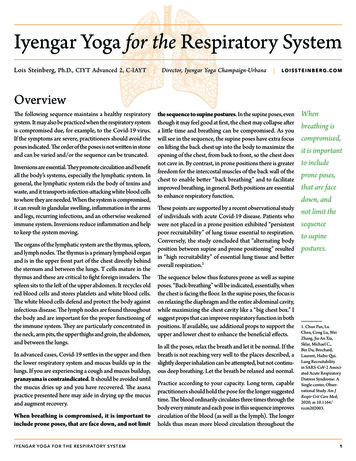
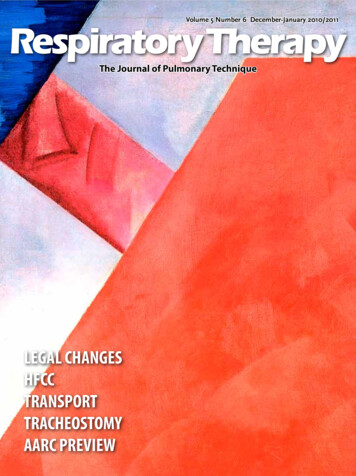

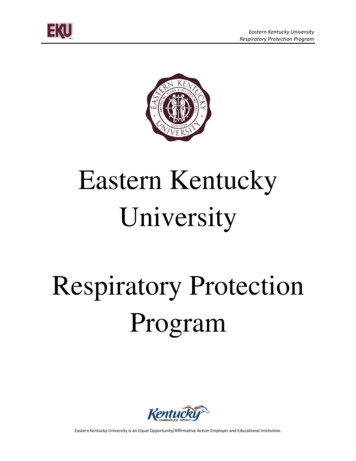
![N95 Respirators Training August 2012 Final - HS [Read-Only]](/img/20/n95-respirators-training.jpg)

